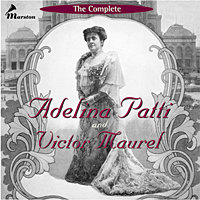
|
The Complete Adelina Patti and Victor Maurel In the second half of the 19th century Adelina Patti and Victor Maurel were arguably the most important opera stars of their day. Patti was peerless. Audiences flocked to see and hear her, from St. Petersburg to San Francisco. Internationally famous authors eulogized her; critics renowned for their severity were unstinting in her praises. Even other prima donnas, members of a breed not noted for generosity to rivals, acknowledged her supremacy. Maurel was the consummate actor with a voice to match. The eminent critic W.J. Henderson declared him "the greatest of singing actors." Verdi chose Maurel to create the role of Iago in Otello and the title-role in Falstaff. Despite the phonograph being invented in the twilight of their careers, history is fortunate to have captured these luminaries on disc. On this two CD set, Patti still evokes the legend that is Patti, and Maurel, often known more for his stage presence than his singing, shines as the singer and not the actor. |
|
|

The importance of Adelina Patti’s recordings cannot be overestimated. For forty years she had been the highest paid opera singer in the world, selling out any house in which she appeared, and setting musical standards for any role she sang. By 1905, the sixty-two year old Patti was still active in concert work but had given up the operatic stage. Not surprisingly, most critics were in agreement that although her voice was still a beautiful and expressive instrument, it was showing obvious signs of decline.
The complete recorded legacy of Adelina Patti presented here seems to accurately reflect the critical opinion of her live performances from the same period. Ever since these records were released, critics and record collectors have been divided as to their merit. Listening to these discs on modern equipment, it is all too easy to hear the numerous flaws—the strident high notes, choppy phrasing, and the obvious shift into the chest register. Equally apparent, however, are the many marvelous aspects of these records, which have made them an indispensable part of any collection of vocal recordings
Victor pressings have been used wherever available to produce this CD set. Thanks to their quiet surfaces, achieving sonic clarity from these discs was relatively easy. Choosing proper playback speeds, however, has been a formidable challenge. No two people seem to agree on this subject. Aida Favia-Arstsay was the first to publish a comprehensive pitching scheme for Patti’s records in The Record Collector (July-August 1956). Since then, Michael Aspinall has published his ideas on the subject in The Record Collector (October-December 1992), and most recently William Moran’s speed suggestions appeared as an appendix in John Frederick Cone’s delightful and definitive biography, Adelina Patti: Queen of Hearts.
In transferring these discs, we have our own theory. Revolutions per minute were not our only guide; we relied on our sense of pitch and a trusty electronic tuning device as well. At the time of these recordings pianos were generally tuned at A=435 Hz as opposed to today’s convention of A=440 Hz. In pitching these records we have, therefore, chosen speeds which result in a pitch slightly below the A=440 standard. The one minor technical flaw common to nearly all Patti’s recordings is a gradual rise in pitch from the beginning to the end of each selection. In transferring these recordings, the pitch has been carefully monitored and the playback speed lowered accordingly.
With careful pitching, each of the 1905 discs play at a slightly different speed, their respective starting speeds ranging from 72.5 to 74.5 rpm. With only slight variation from disc to disc, the first three recordings from the 1906 group have been reproduced with a beginning speed of 72.5 rpm. However, the speeds of the remaining four selections from Patti’s 1906 sessions—the arias from Norma, Mignon, Sonnambula and “La Calesera”—must be reproduced at a starting speed of approximately 73.4 to maintain a pitch consistent with the previous recordings. The resulting keys are E-flat, D-flat, G minor and D-flat respectively. There is nothing unusual about these keys, for indeed D-flat is the original score pitch of the Mignon aria, and G minor is the “Malibran” key for the aria from the La Sonnambula aria. Playback in these keys reveals a mezzo-soprano quality not present in Patti’s other records, and Messrs. Aspinall and Moran prefer to play them one semi-tone higher. We ourselves have been scrutinizing these records for nearly twenty years, and are still perplexed by our own inability to decide the most accurate key for these final discs. Therefore we have chosen to include transfers of each of these selections in both the low and high keys, since no resource exists to definitively solve the mystery.
For a stimulating and perceptive assessment of the recordings of Adelina Patti, readers are enthusiastically referred to J. B. Steane’s The Grand Tradition, currently available from Duckworth Press, and Michael Aspinall’s article for The Record Collector, Vol. 37, # 4.
The recordings of Victor Maurel have also been eagerly sought and prized by collectors, but not so much for their musical value as for their extreme rarity. Many critics have scoffed at these records, claiming that there is little of Maurel’s greatness to be heard on them. This opinion has gained currency primarily because collectors have not been able to play these discs at the proper speeds.
Maurel’s first group of recordings was made in 1903 for the Gramophone and Typewriter Co. in Paris. These discs suffer from a flaw common to all Paris G&Ts of this period; it can be described as a rapid flutter in pitch, resulting from speed instability in the recording turntable. This pitch flutter primarily effects the sound of the piano, but Maurel’s voice is vivid and well recorded. These discs all play at about 70.5 rpm with almost no change in speed within each recording. The transfers presented here were all made from original pressings, using both a 1.5 and a 2.0 mm elliptical truncated stylus.
Victor Maurel’s first group of Fonotipia discs from 1904 all play in the range of 83 rpm except for “Ninon”, which begins at 79.5 and ends at 83 rpm. The second group all play at exactly 76 rpm. With the exception of “Marechiare,” the Fonotipia discs have been transferred from 1930 pressings renowned for their quiet surfaces.
©Jeffrey Miller and Ward Marston